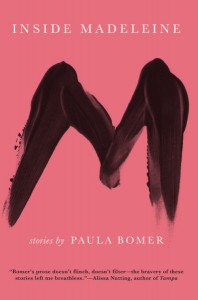

If youth is wasted on the young then perhaps wisdom is wasted on the old. Paula Bomer writes with the wisdom of an adult, but with the heart, the curiosity and the urgency we all grow to one day miss. Her 2012 debut novel Nine Months, an exceedingly raw portrayal of the life of an unhappily pregnant woman, stood out among the year’s best, but her newest short story collection, Inside Madeline shows how much further the author’s talent stretches.
What of the word “raw?” NY Times book reviewer Dana Tortorici in her review of Inside Madeline describes the adjective as a backhanded compliment in reviewer speak. “Half praise, half dis, it commends the struggle to embrace female ugliness while finding the work unsatisfactory. ‘Raw’ work is visceral but also hard to digest—a kind term, in other words, for something half-baked,” she writes. It seems to me what that what she’s describing is the kind of bravery and brazenness so often missing in modern storytelling. The dark and the raw in storytelling is too easily dismissed as young or profane. There are plenty of anodyne stories to consume across all kinds of media, but when I pick up a book of non-genre short stories, I go into it hoping it’s written by an author unafraid to embrace ugly, to delve into the guts of physical and emotional growing pains, loneliness and despair. What’s more universal than that? Otherwise you might as well seek out the literary equivalent of pop music. Bomer’s writing is truly raw, not raw in the way the word has entered book reviewer vocabulary.
Each story in Inside Madeline acquaints us with a different women of a different age and moment in life, grappling with expression, control and autonomy, and the many ways in which the outside world tends to scold them for doing so. Bomer’s characters are often faced with choices, and ultimately with evidence that none of those choices are right or without casualties. First, in “Eye Socket Girls,” she takes unto a hospital for young women with eating disorders, and then into the mind of its patients. She familiarizes us with the logic and the alchemy of their sickness, she accepts us as one of them. In “Reading to the Blind Girl” we meet a Boston University student struggling through a tempestuous relationship. She volunteers to read to a blind student in one her classes. In her relationship with her boyfriend, as in her relationship with the blind woman, she’s made to decide how much herself she’s willing to give. She evokes the sour feeling of giving over too much of one’s self, with such clarity you can feel it in your gut. This is literature tartare.
Often Bomer’s character’s are hiding, playing themselves off as one thing to the world despite the gnawing evidence that they’re something else, but that something else never feels quite right. It’s an uncomfortable suit of skin, but ever relatable. In “Pussies” a young woman finds herself in an amorous relationship with a female friend who is finding herself in punk rock. Her friend goes vegan and gets a tattoo that is “so jail” while always scolding her for always being a step behind in personal evolution. Bomer’s character exists by proxy of her friend’s ever changing identity until she becomes tired of always being the one who submits.
The women in Inside Madeline are subjugated and submissive and put upon and yet they are strong and wise and brave, like all the best heroes. Paula Bomer is one of those rare writers who can fit us snugly into the skin of a character within the confines of a short story. Whether it feels sickly or claustrophobic in that skin, it’s never too much to make you not want to keep turning the pages, and Bomer’s prose is such that you can practically feel the flesh resting slack atop your own–that’s how raw it is.

